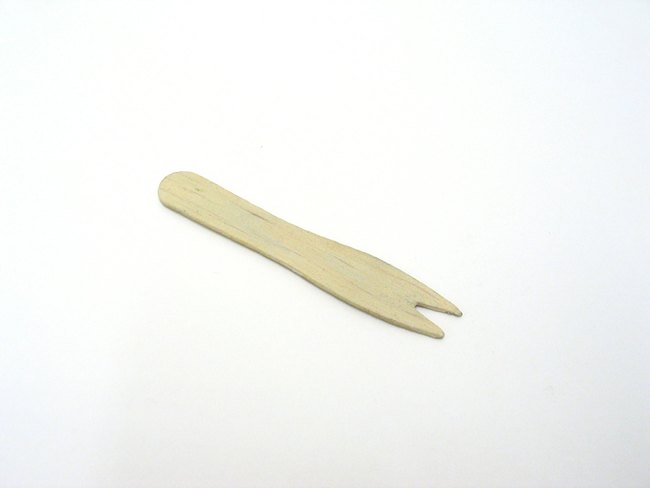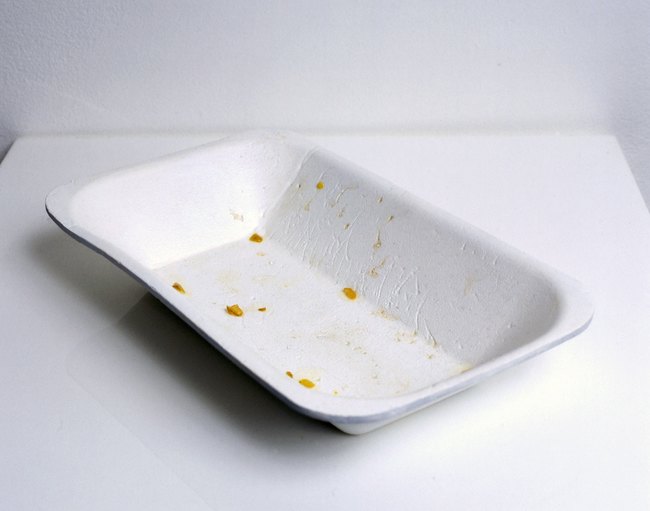AboutEssays2005Chip Trays And Chip Forks
There is perhaps no meal so quintessentially British as fish and chips. Leaving aside the competing claims of the traditional Sunday roast – and the fact that the method of preparing chipped fried potatoes is generally acknowledged to have been imported from France or Belgium – the fish and chip supper has become as much a symbol of Britishness as the Routemaster bus or the (now all but mythical) bowler-hatted city gent.
That is not to say that the dish has been with us since the dawn of Albion. Indeed, it is only known to have been eaten in Britain since the latter half of the nineteenth century – Charles Dickens makes passing references in Oliver Twist and A Tale of Two Cities – when it became a hit with poorer sectors of society. The nation’s fishing fleet had taken to using trawling rather than line methods, resulting in a far greater catch and a consequent lowering in the cost of fish. When combined (around 1870), with the plentiful and inexpensive potato, a meal was created that became the treat of choice for the working classes. By the 1930s – when fish and chips were at the peak of their popularity in Britain – the middle classes were also to be found in the queues outside chippies.
It is not until comparatively recently – and then rather by accident – that the now familiar polystyrene chip tray and the wooden chip fork made their mark on this dish-cum-institution.
The chip tray owes its very existence in large part to the unstable properties of printers ink coupled with a certain squeamishness with regard to standards of food hygiene. From its inception, fish and chips had been wrapped in the cheapest form of packaging available: yesterday’s newspapers. However, in the 1970s and 80s, the owners of newspapers began to experiment with new types of ink. Although these were cheaper, it was discovered that they were also more susceptible to transferring themselves onto the fingers of readers. When the ink came into contact with hot batter and a liberal dose of vinegar, it leapt off the page faster than headlines themselves.
However, contrary to popular belief, there has never been an Act of Parliament banning the use of newspaper as a wrapping for fish and chips. It was environmental health inspectors who took a dim view of this unwelcome new condiment and began to apply pressure on fish and chip shops to discontinue their use of newspapers.
There are several reasons why many chip shop owners sought found a solution in the polystyrene chip tray. They cost less than a couple of pence each, they are feather light and stackable, and they help assistants gauge the correct size of a portion of chips.
However, to say that the chip tray has been taken to the hearts of the public would be to overstate the esteem in which it is held by some margin. Above all else, it suffers from being a very dull object visually. Trays per se are functional articles, a flat surface, usually an oblong, with a raised edge all round. Their simplicity has left them largely impervious to radical changes of design and the chip tray has not bucked the trend. Its all over brilliant whiteness does not help its cause either. Perhaps if all chip trays were post box red or covered in yellow and black stripes or had some other markings that characterised them as chip trays and nothing else, they might establish some sort of tradition and we thus might muster some affection for them. As it is, the overwhelming majority of them are merely the default colour shared by every other object made of expanded polystyrene.
This genericism is mirrored by the chip tray’s function. Despite its name, it can be found in numerous other outlets conveying a range of completely different fast foods to consumers. This compounds the lack of sense of the chip tray being special in any way. Not only is it a banal lifeless thing in the fish and chips world, it repeats its bland uniform monotony wherever else it appears. Understandably, this lends it a feel of the corporate, which does not sit well with the independent spirit of fish and chip shops, the vast majority of which are individually owned, Harry Ramsden’s chain notwithstanding.
Even the fact that the use of such trays spares the hands of consumers from the burns and vinegar seepage that traditional newspaper wrapping was wont to subject them to is outweighed by the argument that the added protection they afford sanitises and thus diminishes the whole fish and chips experience.
If this were not enough, chip trays are fast on their way to joining supermarket plastic bags as the anti-eco-warriors of our times (and, unlike the bags, customers have no option of refusing them). Until recently, they were a source of chlorofluorocarbons (CFC). A very small proportion of them are recyclable. The vast majority are not biodegradable either (biodegradable trays are more expensive and so tend only to be used by chips shops attempting to promote themselves as eco-friendly). Unlike plastic drinks bottles, which biodegrade in five to ten years, or fellow litter icon chewing gum (25 years), polystyrene chip trays will be still be polystyrene chip trays on the day the universe finally collapses in on itself.
Since the chip tray’s useful life extends only for the length of time it takes for a person to eat the food it contains, and that typically that period ends when the consumer is outside, it is no surprise that it has become the archetype of British litter. If a television drama requires a shorthand means of expressing urban grit or rural squalor all that needs be done is to scatter a few used chip trays around the place.
For the sake of authenticity, a number of miniature wooden forks would have to be sedulously strewn around too. In common with the chip tray, the chip fork is a relative newcomer and has found itself just as likely to turn into litter the instant its raison d’être has been exhausted. One could almost argue that, since they are typically bought from wholesalers in job lots of 20,000 at a cost of less than a halfpenny each, chip forks are produced for the express purpose of being thrown away and that the ten-minute period in which they are employed to shovel chips into a mouth is an aberration. As would be pieces of art these are not so much objets trouvés as objets jetés.
At least it can be said that there is some aesthetic pleasure to be gained from them. The organic feel of the wood between the fingers complements the texture of the paper wrap held in the other hand. The chip fork’s sinuous curves, rounded handle and aggressively slanted tines give it the appearance of a Weeble crossed with an angry tadpole. Flipped sideways, however, and it all but disappears, prefiguring its own ineluctable disappearance into the cracks, crevices and fissures of the street, the Bic pen of the pavement. Perhaps, in the end, its most important function is as a delineator of humans beings: after all, what sort of people buy a portion of chips and then imagine themselves too precious to eat them with their fingers?





